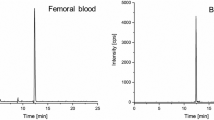Abstract
Aconitum species are commonly used in traditional Chinese medicine, and they have a narrow therapy window due to the possibility of aconitine poisoning. Aconitine poisoning deaths appear infrequently in forensic practice. It is important to collect valuable body samples in time due to the rapid absorption and excretion of aconitine. However, it is unknown whether postmortem samples have value for toxicological analysis if the deceased has experienced long-term treatment before death. Herein, we present a case of a woman who died after 12 days of failed active treatment for aconitine poisoning. Aconitine was detected in the liver tissue. To our knowledge, this is the first case report describing the detection of aconitine in a decedent after long-term active treatment. The findings indicated that the aconitine concentration in liver tissue can be maintained after long-term treatment; this information may therefore serve as a reference in forensic practice.




Similar content being viewed by others
Data availability
The data that support the findings of this study can be freely available to any researcher wishing to use them for non-commercial purposes.
Reference
Chan TY. Aconitum Alkaloid Poisoning Because of Contamination of Herbs by Aconite Roots. Phytother Res. 2016;30(1):3–8. https://doi.org/10.1002/ptr.5495.
Wu X, Wang S, Lu J, et al. Seeing the unseen of Chinese herbal medicine processing (Paozhi): advances in new perspectives. Chin Med. 2018;13:4. https://doi.org/10.1186/s13020-018-0163-3.
Zhao Z, Liang Z, Chan K, et al. A unique issue in the standardization of Chinese materia medica: processing. Planta Med. 2010;76(17):1975–86. https://doi.org/10.1055/s-0030-1250522.
Gao Y, Fan H, Nie A, et al. Aconitine: A review of its pharmacokinetics, pharmacology, toxicology and detoxification. J Ethnopharmacol. 2022;293: 115270. https://doi.org/10.1016/j.jep.2022.11527.
Chan TY. Aconite poisoning. Clin Toxicol (Phila). 2009;47(4):279–85. https://doi.org/10.1080/15563650902904407.
Liu Q, Zhuo L, Liu L, et al. Seven cases of fatal aconite poisoning: forensic experience in China. Forensic Sci Int. 2011;212(1–3):e5–9. https://doi.org/10.1016/j.forsciint.2011.05.00.
Bicker W, Monticelli F, Bauer A, et al. Quantification of aconitine in post-mortem specimens by validated liquid chromatography-tandem mass spectrometry method: three case reports on fatal “monkshood” poisoning. Drug Test Anal. 2013;5(9–10):753–62. https://doi.org/10.1002/dta.1501.
Moritz F, Compagnon P, Kaliszczak IG, et al. Severe acute poisoning with homemade Aconitum napellus capsules: toxicokinetic and clinical data. Clin Toxicol (Phila). 2005;43(7):873–6. https://doi.org/10.1080/15563650500357594.
Fujita Y, Terui K, Fujita M, et al. Five cases of aconite poisoning: toxicokinetics of aconitines. Journal of analytical toxicology. 2007;31(3):132–7. https://doi.org/10.1093/jat/31.3.132.
Forensic Identification Bureau, Ministry of Justice of the People’s Republic of China. General rules for the validati-on of forensic toxicological analys-is methods: SF/Z 0063–2020[S], China Standard Publishing House, Beijing, 2020.
Arlt EM, Keller Th, Wittmann H, et al. Fatal aconitine intoxication or thyroid storm? A case report Legal Medicine. 2012;14(3):154–6. https://doi.org/10.1016/j.legalmed.2012.01.003.
Niitsu H, Fujita Y, Fujita S, et al. Distribution of Aconitum alkaloids in autopsy cases of aconite poisoning. Forensic science international. 2013;227(1–3):111–7. https://doi.org/10.1016/j.forsciint.2012.10.021.
Chan TY. Contributory factors in herb-induced fatal aconite poisoning. Forensic Sci Int. 2012;223(1–3):40–3. https://doi.org/10.1016/j.forsciint.2012.10.009.
Zhou W, Liu H, Qiu LZ, et al. Cardiac efficacy and toxicity of aconitine: A new frontier for the ancient poison. Med Res Rev. 2021;223(1–3):40–3. https://doi.org/10.1002/med.21777.
Li H, Liu L, Zhu S, et al. Case reports of aconite poisoning in mainland China from 2004 to 2015: A retrospective analysis. J Forensic Leg Med. 2016;42:68–73. https://doi.org/10.1016/j.jflm.2016.05.016.
Acknowledgement
This study was supported by Key Laboratory of Forensic Toxicology Analysis of the Ministry of Public Security (2020FTDWFX04). We thank associate professor Dong Ying for offering a consultant for the toxicological tests. We thank Ma Jinghong for his assistance in the toxicological tests.
Funding
Key Laboratory of Forensic Toxicology Analysis of the Ministry of Public Security, 2 020 FTDWFX04, Hongmei Dong
Author information
Authors and Affiliations
Corresponding author
Ethics declarations
Ethics approval
All data and sample collections were handled in strict accordance with the ethical guidelines of the Tongji Medical College, Huazhong University of Science and Technology.
Informed consent
Informed consent was obtained from the family members of the deceased.
Conflict of interest
The authors declare that they have no conflict of interest.
Additional information
Publisher's Note
Springer Nature remains neutral with regard to jurisdictional claims in published maps and institutional affiliations.
Supplementary Information
Below is the link to the electronic supplementary material.
Rights and permissions
Springer Nature or its licensor (e.g. a society or other partner) holds exclusive rights to this article under a publishing agreement with the author(s) or other rightsholder(s); author self-archiving of the accepted manuscript version of this article is solely governed by the terms of such publishing agreement and applicable law.
About this article
Cite this article
Weisheng, H., Shuquan, Z., Weiwei, Z. et al. Fatal poisoning due to aconite: Autopsy findings and postmortem quantitative analysis. Forensic Sci Med Pathol (2023). https://doi.org/10.1007/s12024-023-00728-w
Accepted:
Published:
DOI: https://doi.org/10.1007/s12024-023-00728-w




